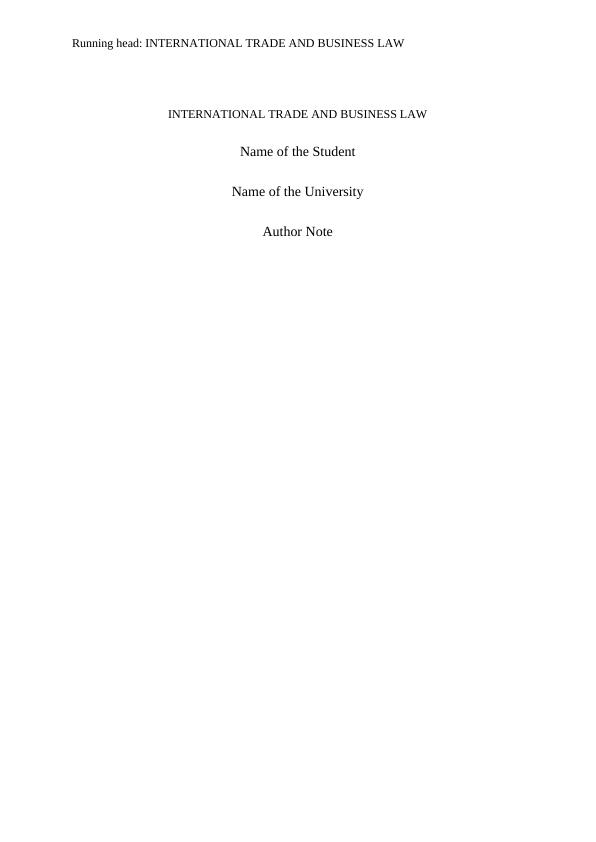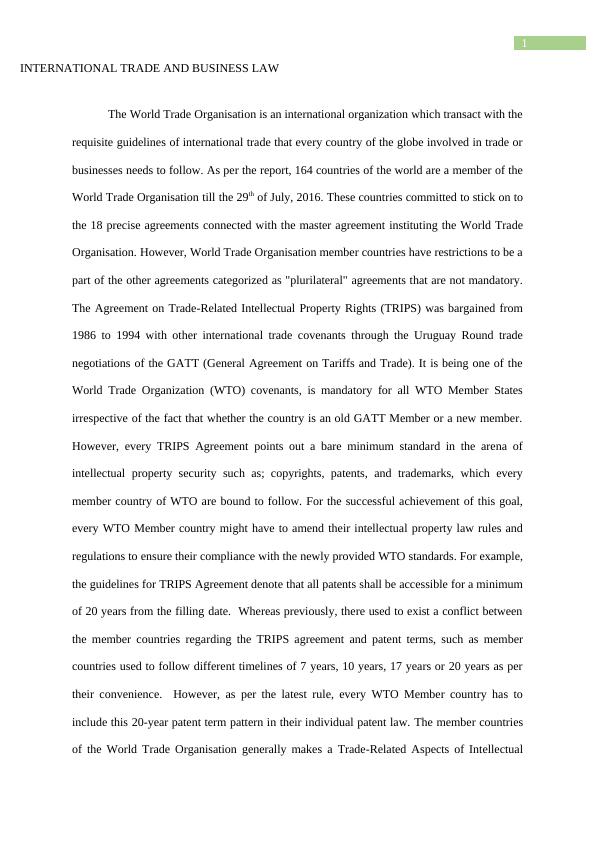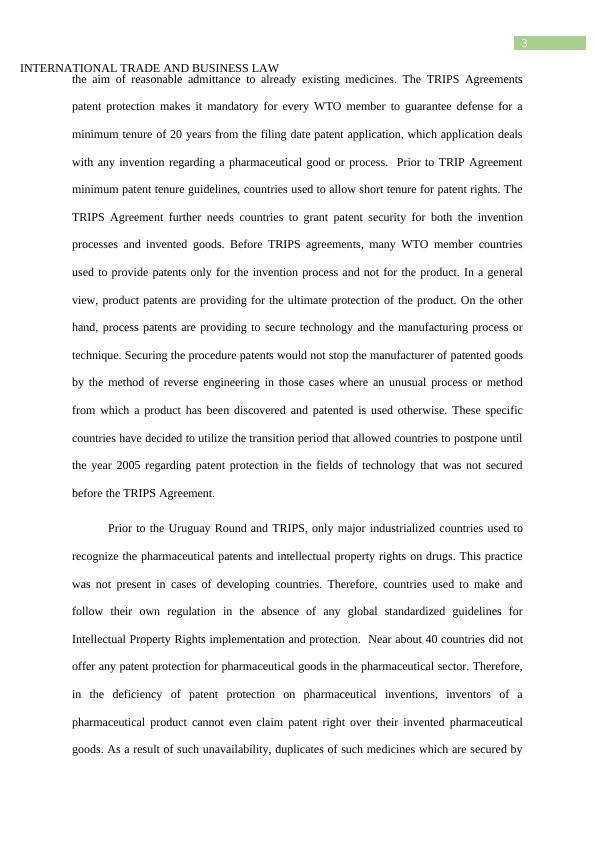The international trade and business l aw
Added on 2022-08-21
17 Pages5110 Words20 Views
Running head: INTERNATIONAL TRADE AND BUSINESS LAW
INTERNATIONAL TRADE AND BUSINESS LAW
Name of the Student
Name of the University
Author Note
INTERNATIONAL TRADE AND BUSINESS LAW
Name of the Student
Name of the University
Author Note

1
INTERNATIONAL TRADE AND BUSINESS LAW
The World Trade Organisation is an international organization which transact with the
requisite guidelines of international trade that every country of the globe involved in trade or
businesses needs to follow. As per the report, 164 countries of the world are a member of the
World Trade Organisation till the 29th of July, 2016. These countries committed to stick on to
the 18 precise agreements connected with the master agreement instituting the World Trade
Organisation. However, World Trade Organisation member countries have restrictions to be a
part of the other agreements categorized as "plurilateral" agreements that are not mandatory.
The Agreement on Trade-Related Intellectual Property Rights (TRIPS) was bargained from
1986 to 1994 with other international trade covenants through the Uruguay Round trade
negotiations of the GATT (General Agreement on Tariffs and Trade). It is being one of the
World Trade Organization (WTO) covenants, is mandatory for all WTO Member States
irrespective of the fact that whether the country is an old GATT Member or a new member.
However, every TRIPS Agreement points out a bare minimum standard in the arena of
intellectual property security such as; copyrights, patents, and trademarks, which every
member country of WTO are bound to follow. For the successful achievement of this goal,
every WTO Member country might have to amend their intellectual property law rules and
regulations to ensure their compliance with the newly provided WTO standards. For example,
the guidelines for TRIPS Agreement denote that all patents shall be accessible for a minimum
of 20 years from the filling date. Whereas previously, there used to exist a conflict between
the member countries regarding the TRIPS agreement and patent terms, such as member
countries used to follow different timelines of 7 years, 10 years, 17 years or 20 years as per
their convenience. However, as per the latest rule, every WTO Member country has to
include this 20-year patent term pattern in their individual patent law. The member countries
of the World Trade Organisation generally makes a Trade-Related Aspects of Intellectual
INTERNATIONAL TRADE AND BUSINESS LAW
The World Trade Organisation is an international organization which transact with the
requisite guidelines of international trade that every country of the globe involved in trade or
businesses needs to follow. As per the report, 164 countries of the world are a member of the
World Trade Organisation till the 29th of July, 2016. These countries committed to stick on to
the 18 precise agreements connected with the master agreement instituting the World Trade
Organisation. However, World Trade Organisation member countries have restrictions to be a
part of the other agreements categorized as "plurilateral" agreements that are not mandatory.
The Agreement on Trade-Related Intellectual Property Rights (TRIPS) was bargained from
1986 to 1994 with other international trade covenants through the Uruguay Round trade
negotiations of the GATT (General Agreement on Tariffs and Trade). It is being one of the
World Trade Organization (WTO) covenants, is mandatory for all WTO Member States
irrespective of the fact that whether the country is an old GATT Member or a new member.
However, every TRIPS Agreement points out a bare minimum standard in the arena of
intellectual property security such as; copyrights, patents, and trademarks, which every
member country of WTO are bound to follow. For the successful achievement of this goal,
every WTO Member country might have to amend their intellectual property law rules and
regulations to ensure their compliance with the newly provided WTO standards. For example,
the guidelines for TRIPS Agreement denote that all patents shall be accessible for a minimum
of 20 years from the filling date. Whereas previously, there used to exist a conflict between
the member countries regarding the TRIPS agreement and patent terms, such as member
countries used to follow different timelines of 7 years, 10 years, 17 years or 20 years as per
their convenience. However, as per the latest rule, every WTO Member country has to
include this 20-year patent term pattern in their individual patent law. The member countries
of the World Trade Organisation generally makes a Trade-Related Aspects of Intellectual

2
INTERNATIONAL TRADE AND BUSINESS LAW
Property Rights (TRIPS) between them to do international trading between them Therefore,
Trade-Related Aspects of Intellectual Property Rights (TRIPS) can be categorized as a
covenant to create a business relationship between world countries. However, this type of
agreement has a powerful effect on the pharmaceutical sectors and admittance to medicines.
The aim of this study is to scrutinize the influence of the TRIPS agreement on the world
pharmaceutical industry1.
TRIPS Agreement delivers detailed requirements for the implementation of
intellectual property rights. The TRIPS covenants has been in the system since 1995, and to
date, it has been categorized as the most wide-ranging multilateral contract on intellectual
property matters. The TRIPS Agreement launch the universal standards for defending and
enforcing almost every form of intellectual property rights (IPR), together with those
involving patent rights. However, the International conventions before TRIPS did not
indicate the bare minimum requisites for patents. During the time TRIP negotiations began,
almost 40 of the world countries did not allow patent safety for pharmaceutical goods.
Nowadays, the TRIPS Agreement necessitates all WTO members to adjust their laws
according to the minimum guidelines for IPR protection.
However, Trip agreements also state out provisions that allows wide-ranging
flexibility and satisfactory opportunities for the WTO member countries to tactfully deal with
their patent rights and intellectual property systems. Further to meet their developmental
requirements. Therefore, it can be said that these countries have some kind of freedom or
authority in cases of modifying or altering their intellectual property rules and regulations.
Therefore, there exists an ample number of options for these countries in preparing the global
legislation for their states to guarantee an appropriate balance between the aim of providing
encouragement to the researchers of these countries for future discoveries of new drugs and
1 Cornish, William, and Kathleen Liddell. "The Origins and Structure of the TRIPS Agreement." (2016) TRIPS
plus 20. Springer, Berlin, Heidelberg,. 3-51.
INTERNATIONAL TRADE AND BUSINESS LAW
Property Rights (TRIPS) between them to do international trading between them Therefore,
Trade-Related Aspects of Intellectual Property Rights (TRIPS) can be categorized as a
covenant to create a business relationship between world countries. However, this type of
agreement has a powerful effect on the pharmaceutical sectors and admittance to medicines.
The aim of this study is to scrutinize the influence of the TRIPS agreement on the world
pharmaceutical industry1.
TRIPS Agreement delivers detailed requirements for the implementation of
intellectual property rights. The TRIPS covenants has been in the system since 1995, and to
date, it has been categorized as the most wide-ranging multilateral contract on intellectual
property matters. The TRIPS Agreement launch the universal standards for defending and
enforcing almost every form of intellectual property rights (IPR), together with those
involving patent rights. However, the International conventions before TRIPS did not
indicate the bare minimum requisites for patents. During the time TRIP negotiations began,
almost 40 of the world countries did not allow patent safety for pharmaceutical goods.
Nowadays, the TRIPS Agreement necessitates all WTO members to adjust their laws
according to the minimum guidelines for IPR protection.
However, Trip agreements also state out provisions that allows wide-ranging
flexibility and satisfactory opportunities for the WTO member countries to tactfully deal with
their patent rights and intellectual property systems. Further to meet their developmental
requirements. Therefore, it can be said that these countries have some kind of freedom or
authority in cases of modifying or altering their intellectual property rules and regulations.
Therefore, there exists an ample number of options for these countries in preparing the global
legislation for their states to guarantee an appropriate balance between the aim of providing
encouragement to the researchers of these countries for future discoveries of new drugs and
1 Cornish, William, and Kathleen Liddell. "The Origins and Structure of the TRIPS Agreement." (2016) TRIPS
plus 20. Springer, Berlin, Heidelberg,. 3-51.

3
INTERNATIONAL TRADE AND BUSINESS LAW
the aim of reasonable admittance to already existing medicines. The TRIPS Agreements
patent protection makes it mandatory for every WTO member to guarantee defense for a
minimum tenure of 20 years from the filing date patent application, which application deals
with any invention regarding a pharmaceutical good or process. Prior to TRIP Agreement
minimum patent tenure guidelines, countries used to allow short tenure for patent rights. The
TRIPS Agreement further needs countries to grant patent security for both the invention
processes and invented goods. Before TRIPS agreements, many WTO member countries
used to provide patents only for the invention process and not for the product. In a general
view, product patents are providing for the ultimate protection of the product. On the other
hand, process patents are providing to secure technology and the manufacturing process or
technique. Securing the procedure patents would not stop the manufacturer of patented goods
by the method of reverse engineering in those cases where an unusual process or method
from which a product has been discovered and patented is used otherwise. These specific
countries have decided to utilize the transition period that allowed countries to postpone until
the year 2005 regarding patent protection in the fields of technology that was not secured
before the TRIPS Agreement.
Prior to the Uruguay Round and TRIPS, only major industrialized countries used to
recognize the pharmaceutical patents and intellectual property rights on drugs. This practice
was not present in cases of developing countries. Therefore, countries used to make and
follow their own regulation in the absence of any global standardized guidelines for
Intellectual Property Rights implementation and protection. Near about 40 countries did not
offer any patent protection for pharmaceutical goods in the pharmaceutical sector. Therefore,
in the deficiency of patent protection on pharmaceutical inventions, inventors of a
pharmaceutical product cannot even claim patent right over their invented pharmaceutical
goods. As a result of such unavailability, duplicates of such medicines which are secured by
INTERNATIONAL TRADE AND BUSINESS LAW
the aim of reasonable admittance to already existing medicines. The TRIPS Agreements
patent protection makes it mandatory for every WTO member to guarantee defense for a
minimum tenure of 20 years from the filing date patent application, which application deals
with any invention regarding a pharmaceutical good or process. Prior to TRIP Agreement
minimum patent tenure guidelines, countries used to allow short tenure for patent rights. The
TRIPS Agreement further needs countries to grant patent security for both the invention
processes and invented goods. Before TRIPS agreements, many WTO member countries
used to provide patents only for the invention process and not for the product. In a general
view, product patents are providing for the ultimate protection of the product. On the other
hand, process patents are providing to secure technology and the manufacturing process or
technique. Securing the procedure patents would not stop the manufacturer of patented goods
by the method of reverse engineering in those cases where an unusual process or method
from which a product has been discovered and patented is used otherwise. These specific
countries have decided to utilize the transition period that allowed countries to postpone until
the year 2005 regarding patent protection in the fields of technology that was not secured
before the TRIPS Agreement.
Prior to the Uruguay Round and TRIPS, only major industrialized countries used to
recognize the pharmaceutical patents and intellectual property rights on drugs. This practice
was not present in cases of developing countries. Therefore, countries used to make and
follow their own regulation in the absence of any global standardized guidelines for
Intellectual Property Rights implementation and protection. Near about 40 countries did not
offer any patent protection for pharmaceutical goods in the pharmaceutical sector. Therefore,
in the deficiency of patent protection on pharmaceutical inventions, inventors of a
pharmaceutical product cannot even claim patent right over their invented pharmaceutical
goods. As a result of such unavailability, duplicates of such medicines which are secured by

End of preview
Want to access all the pages? Upload your documents or become a member.
Related Documents
Intellectual Property: Protection, Plagiarism, Open Source Code, and Cybersquattinglg...
|5
|999
|246
Objectives of TRIPS - Assignmentlg...
|8
|2020
|437
International Commercial Lawlg...
|16
|3735
|480
Intellectual Property and Human Rightslg...
|4
|557
|450
International Intellectual Property Lawlg...
|11
|3678
|2
Is the World Trade Organisation still fit for the purpose?lg...
|11
|3866
|66
